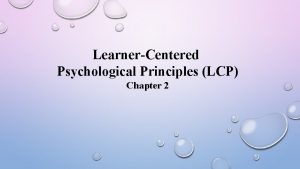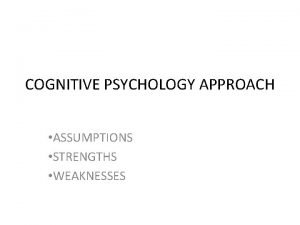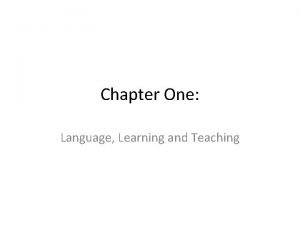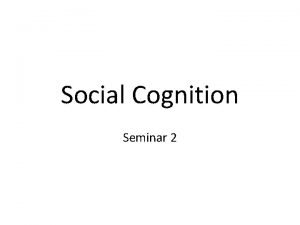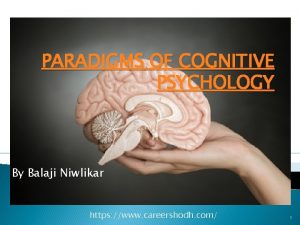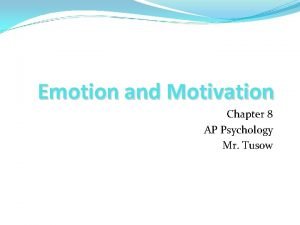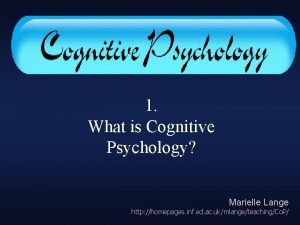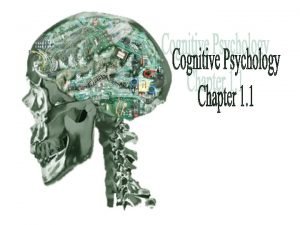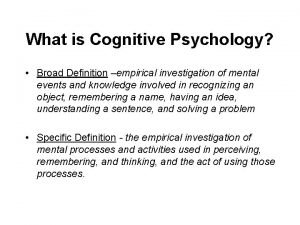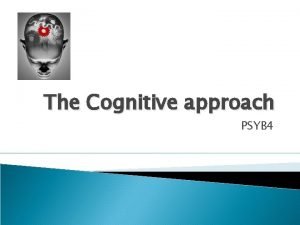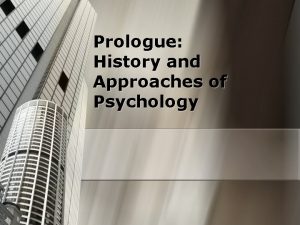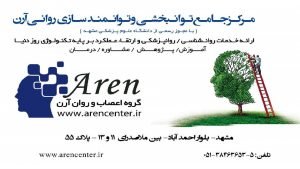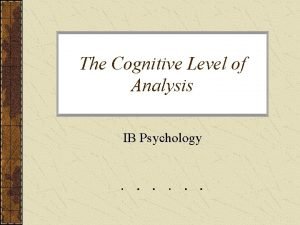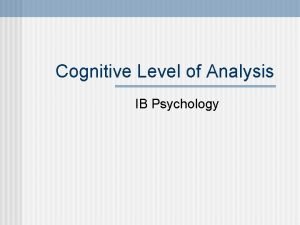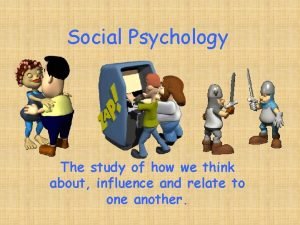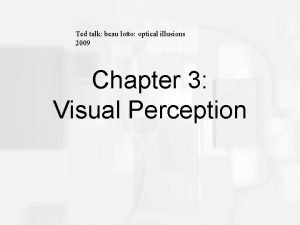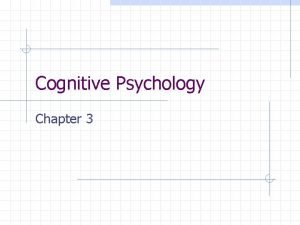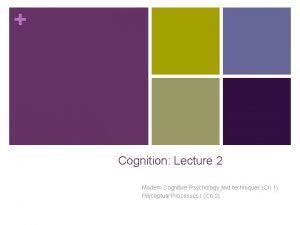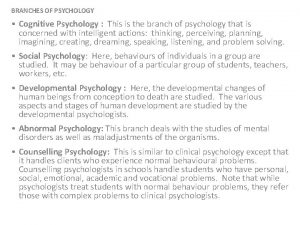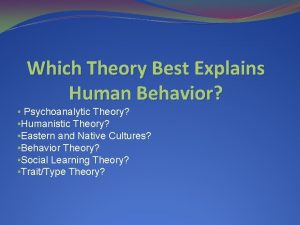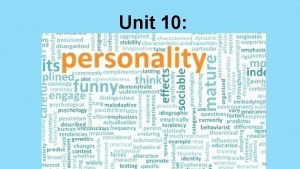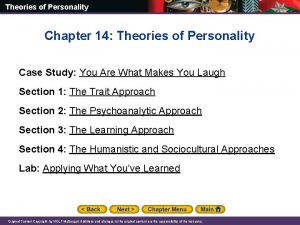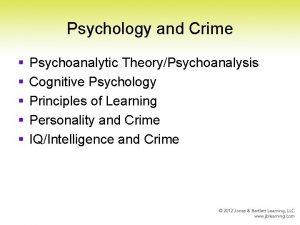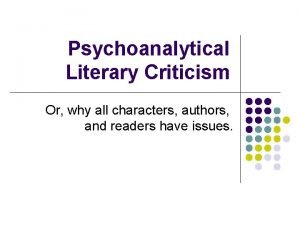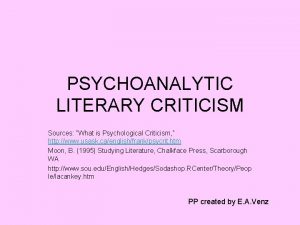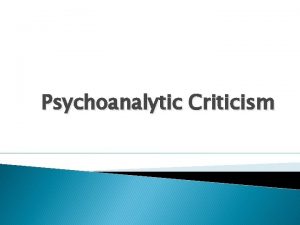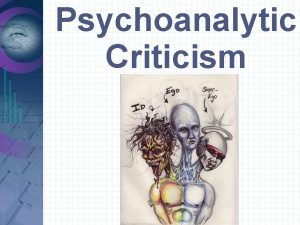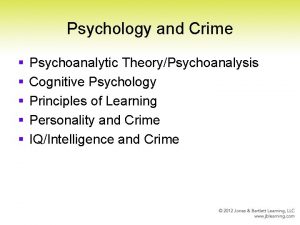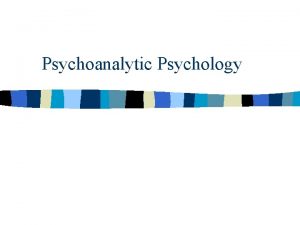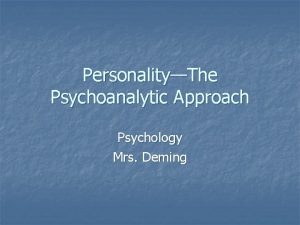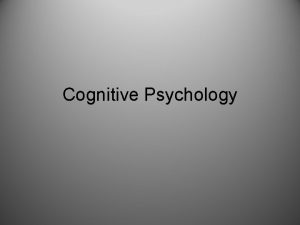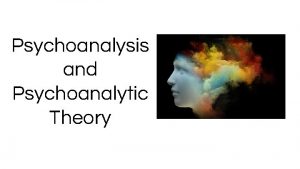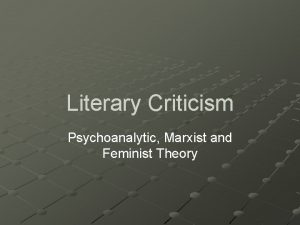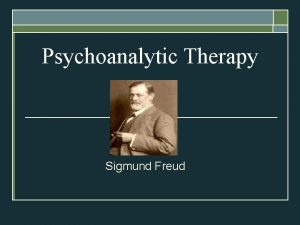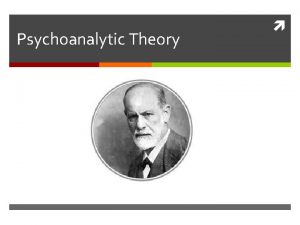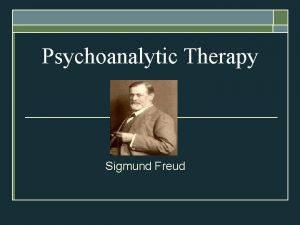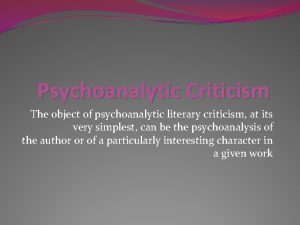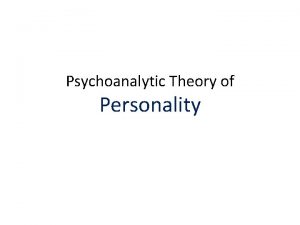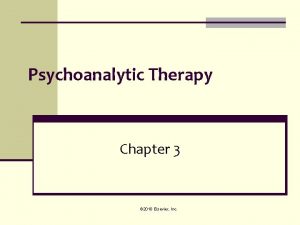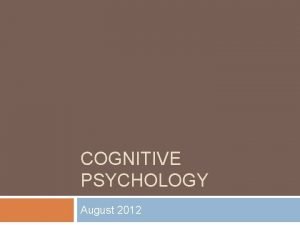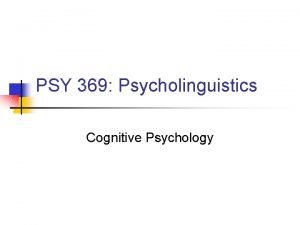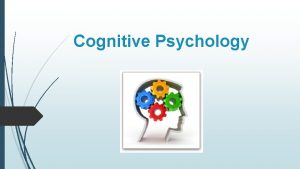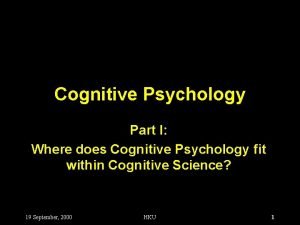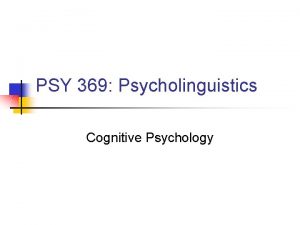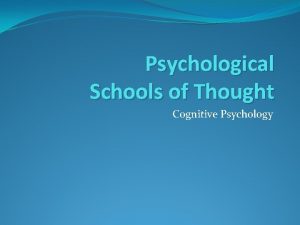Psychology and Crime Psychoanalytic TheoryPsychoanalysis Cognitive Psychology Principles




































- Slides: 36

Psychology and Crime § § § Psychoanalytic Theory/Psychoanalysis Cognitive Psychology Principles of Learning Personality and Crime IQ/Intelligence and Crime

Psychoanalytic Theory ▪ Sigmund Freud ▪ 1856– 1939 ▪ Psychic Determinism § A CIGAR IS NEVER JUST A CIGAR

Freudian Elements of Personality ▪ Conscious vs. Unconscious Mind ▪ Id: “If it feels good, do it!” ▪ Superego: conscience— “Stealing is wrong. ” ▪ Ego: psychological thermostat that regulates the wishes of the id with the social restrictions of the superego

Defense Mechanisms ▪ Used to reduce anxiety § REPRESSION § RATIONALIZATION § DENIAL § PROJECTION

Freudian Explanations of Delinquency ▪ Overactive Id ▪ Delinquent Superego ▪ Delinquent Ego § Crimes with “special meaning” § Translating psychoanalysis into rehabilitation? § Works for articulate adult neurotics who can talk out their problems…

Policy Implications of Freudian Theory ▪ Drawbacks ▪ Almost impossible to test empirically (Cannot be directly observed and measured) ▪ Still maintains a place in psychology of criminal behavior § Many concepts from Freud used in modern theory – LOW SELF CONTROL – PRO-CRIMINAL ATTITUDES

Principles of Learning ▪ Three types of learning ▪ ▪ ▪ Classical conditioning Operant conditioning Observational (vicarious) learning

Classical Conditioning

Principles of Learning ▪ Positive reinforcement: increases the target behavior by rewarding the individual ▪ Negative reinforcement: increases the target behavior by removing an unpleasant stimulus ▪ Punishment: reduces the odds of the target behavior being repeated

Principles of Learning ▪ Delinquency tied to parents’ failure to effectively condition their children away from bad behavior § Inconsistent and harsh punishment (Glueck and Glueck). ▪ Effective parenting (monitoring, punishing, and reinforcing behavior) nondeliquent children (Patterson). ▪ Parental behaviors may have few effects on the child’s long-term development (Harris).

How to Train Your Parent

Principles of Learning GERALD PATTERSON AND FRIENDS

Observational Learning ▪ Albert Bandura (Bobo doll experiments): most human learning is not based on trial and error (operant conditioning). ▪ Effects on criminal behaviors are difficult to determine.

Media and Crime ▪ Does media (TV and movies) influence aggression, violence, and criminal behavior? ▪ Conducive to role modeling ▪ Perpetrators not punished ▪ Targets of violence show little pain ▪ Few long-term negative consequences § Some evidence (but still debate)—reducing exposure may reduce aggression

Policy Implications of Behaviorism ▪ Criminals can learn pro-social behaviors to replace criminal actions. ▪ Classical Conditioning Aversion therapy ▪ Operant Conditioning Token economy

Cognitive Psychology ▪ ▪ ▪ Humans’ ability to engage in complex thoughts influences behavior. Cognitions (like behaviors) can be learned. Focus on: ▪ ▪ Cognitive structure (how people think) Cognitive content (what people think)

Cognitive Structure ▪ Kohlberg's theory of moral reasoning: humans advance through predictable stages of moral reasoning ▪ Self-control ▪ Ability to empathize ▪ Ability to anticipate consequences ▪ Ability to control anger

Kohlberg’s Stages of Moral Development (1 of 2) ▪ Stage 1 ▪ Right is blindly obeying those with power and authority. ▪ Emphasis is on avoiding punishment. ▪ Interests of others are not considered. ▪ Stage 2 ▪ Right is furthering one’s own interests. ▪ Interests of others are important only as a way to satisfy self-interests. ▪ Stage 3 ▪ Moral reasoning is motivated by loyalties to others and a desire to live up to other’s standards.

Kohlberg’s Stages of Moral Development (2 of 2) ▪ Stage 4 ▪ Right is following the rules of society and maintaining important social institutions (e. g. , family, community). ▪ Stage 5 ▪ Moral decisions are made by weighing individual rights against legal principles and the common good. ▪ Stage 6 ▪ Moral decisions are based on universal principles (e. g. , human dignity, desire for justice). ▪ Principles are considered across different contexts and are independent of the law.

Cognitive Content ▪ Rationalizations or denials that support criminal behavior ▪ For example, a criminal thinks, “I’m not really hurting anyone. ” § Extremely common for sex offenders ▪ Criminals are more likely to express such thoughts § Sociologists are often skeptical (time-ordering) § Psychologists: NEGATIVE REINFORCEMENT ▪

Policy Implications of Cognitive Psychology ▪ Cognitive theory translates easily into practice. § Cognitive skills programs teach offenders cognitive skills like moral reasoning, anger management, or self-control. § Cognitive restructuring attempts to change the content of an individual’s thoughts. ▪ Combination cognitive-behavioral have track record of success

Theory in Action ▪ Multisystematic therapy (MST) ▪ ▪ ▪ Creator Scott Henggeler and associates Reduces criminal behavior Comprehensive approach Targets many areas for change Uses many different techniques (not just cognitive-behavioral programs)

Personality and Crime ▪ Crime and delinquency related to the presence of some personality trait ▪ Personality trait: a characteristic of an individual that is stable over time and across different social circumstances ▪ Personality: the sum of personality traits that define a person

Personality Traits and Crime (1 of 3) ▪ A number of related traits combine to form super factors ▪ Several different models ▪ Five-factor model ▪ Tellegen’s personality model ▪ Recent studies use the Multidimensional Personality Questionnaire (MPQ)

Personality Traits and Crime (2 of 3) ▪ Personality dimensions in the MPQ ▪ Constraint ▪ Traditionalism ▪ Harm avoidance ▪ Control ▪ Negative emotionality ▪ Aggression ▪ Alienation ▪ Stress reaction

Personality Traits and Crime (3 of 3) ▪ Personality dimensions in the MPQ ▪ Positive emotionality ▪ ▪ Achievement Social potency Well-being Social closeness

Criminal Personality: The Psychopath ▪ A distinct “criminal personality” ▪ One of the oldest concepts in criminology § “MORAL INSANITY”

Antisocial Personality Disorder (APD) from DSM-IV 1. Disregard for the rights of others. At least three of the following: behaves in a way that is grounds for arrest, deceitful and manipulative, impulsive, aggressive, irresponsible, lack of remorse 2. Age 18 or older 3. A history of child conduct disorder 4. Antisocial behavior not a product of schizophrenic episode

“Psychopath” is narrower concept § Hervey Cleckley’s (1957) The Mask of Sanity § Key features: Manipulative, Superficial charm, Above-average intelligence, Absence of psychotic symptoms, Absence of anxiety, Lack of remorse, Failure to learn from experience, Egocentric, Lack of emotional depth § Other Characteristics: Trivial Sex life, Unreliable, Failure to follow a life plan, Untruthful, Suicide attempts rarely genuine, Impulsive, Antisocial behavior

HARE PCL § The Psychopathy Checklist § Interview § Measures different aspects of psychopathy (each scored on a 0 -2 scale) § Has produced very interesting studies (difference between psychopath and nonpsychopath inmates)

Policy Implications of Personality Theory ▪ Personality traits consistently predict delinquency and crime. ▪ Criticisms: § Personality traits are often portrayed as impossible to change (See, Psychopathy) § What causes personality traits?

Intelligence and Crime ▪ “Feeblemindedness” was once thought to be a cause of crime. ▪ What exactly is IQ and how does it relate to criminal behavior?

A Brief History of Intelligence Testing ▪ Binet started out like his peers: Measuring people’s skull size § Not much difference—worried about bias in the tests § Developed a “hodgepodge” of tests measure identify learning disabled children § Not meant to be a measuring device for intelligence in “normal” students § Translated to English, used to identify “morons” and “low grade defectives” as part of eugenics

IQ and Crime ▪ There is an IQ gap of 8– 10 points between criminals and noncriminals, even when statistically controlled for race and social class. ▪ IQ is not a very strong indicator of criminal behavior. § But, it does consistently predict

IQ and Crime ▪ Travis Hirschi and Michael Hindelang ▪ The Bell Curve ▪Direct effect ▪ Most criminologists find evidence of indirect effects IQ School, Peers, etc. Crime

Conclusion ▪ Psychological theories the individual ▪ Modern Theory § LEARNING § COGNITION and IQ § PERSONALITY ▪ Many psychological theories translate well into treatment programs.
 Cognitive and non cognitive religious language
Cognitive and non cognitive religious language Lcp principles
Lcp principles Strengths of the cognitive approach
Strengths of the cognitive approach Structural linguistic and behavioral psychology
Structural linguistic and behavioral psychology Cognitive psychology concepts
Cognitive psychology concepts 4 paradigms of cognitive psychology
4 paradigms of cognitive psychology Emphasis
Emphasis Cognitive appraisal psychology definition
Cognitive appraisal psychology definition 5 major domains of psychology
5 major domains of psychology Cognitive economy psychology definition
Cognitive economy psychology definition Computer metaphor psychology
Computer metaphor psychology History of cognitive psychology
History of cognitive psychology History of cognitive psychology
History of cognitive psychology Definition of cognitive psychology
Definition of cognitive psychology Cognitive approach definition
Cognitive approach definition Cognitive psychology crash course
Cognitive psychology crash course Cognitive model psychology
Cognitive model psychology Cognitive psychology ppt
Cognitive psychology ppt Ib psychology cognitive level of analysis
Ib psychology cognitive level of analysis Ib psychology cognitive level of analysis
Ib psychology cognitive level of analysis Cognitive dissonance ap psych
Cognitive dissonance ap psych Token economy in psychology
Token economy in psychology Cognitive psychology
Cognitive psychology Transduction psychology
Transduction psychology Cognitive psychology
Cognitive psychology Branches of psychology
Branches of psychology Criminal psychology means
Criminal psychology means The freudian concept of the ego is best described as *
The freudian concept of the ego is best described as * Carl rogers theory
Carl rogers theory Freud fixations
Freud fixations Difference between psychoanalysis and psychodynamic
Difference between psychoanalysis and psychodynamic What does the psychoanalytic approach to personality teach?
What does the psychoanalytic approach to personality teach? Psychoanalytic theory criminology
Psychoanalytic theory criminology Sexlll
Sexlll Define psychoanalytic criticism
Define psychoanalytic criticism Definition of psychoanalytic criticism
Definition of psychoanalytic criticism Definition of psychoanalytic criticism
Definition of psychoanalytic criticism

